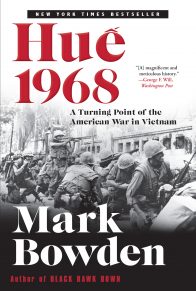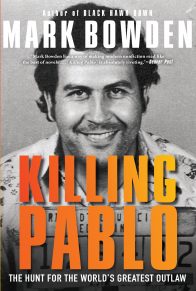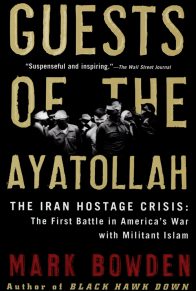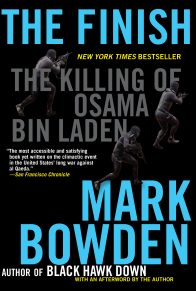At liftoff, Matt Eversmann said a Hail Mary. He was curled into a seat between two helicopter crew chiefs, the knees of his long legs up to his shoulders. Before him, jammed on both sides of the Black Hawk helicopter, was his “chalk,” twelve young men in flak vests over tan desert camouflage fatigues.
He knew their faces so well they were like brothers. The older guys on this crew, like Eversmann, a staff sergeant with five years in at age twenty-six, had lived and trained together for years. Some had come up together through basic training, jump school, and Ranger school. They had traveled the world, to Korea, Thailand, Central America … they knew each other better than most brothers did.
They’d been drunk together, gotten into fights, slept on forest floors, jumped out of airplanes, climbed mountains, shot down foaming rivers with their hearts in their throats, baked and frozen and starved together, passed countless bored hours, teased one another endlessly about girlfriends or lack of same, driven out in the middle of the night from Fort Benning to retrieve each other from some diner or strip club out on Victory Drive after getting drunk and falling asleep or pissing off some barkeep. Through all those things, they had been training for a moment like this. It was the first time the lanky sergeant had been put in charge, and he was nervous about it.
Pray for us sinners, now, and at the hour of our death, amen.
It was midafternoon, October 3, 1993. Eversmann’s Chalk Four was part of a force of U.S. Army Rangers and Delta Force operators who were about to drop in uninvited on a gathering of Habr Gidr clan leaders in the heart of Mogadishu, Somalia. This ragged clan, led by warlord Mohamed Farrah Aidid, had picked a fight with the United States of America, and it was, without a doubt, going down. Today’s targets were two of Aidid’s lieutenants. They would be arrested and imprisoned with a growing number of the belligerent clan’s bosses on an island off the southern Somali coast city of Kismayo. Chalk Four’s piece of this snatch-and-grab was simple. Each of the four Ranger chalks had a corner of the block around the target house. Eversmann’s would rope down to the northwest corner and set up a blocking position. With Rangers on all four corners, no one would enter the zone where Delta was working, and no one would leave.
They had done this dozens of times without difficulty, in practice and on the task force’s six previous missions. The pattern was clear in Eversmann’s mind. He knew which way to move when he hit the ground, where his soldiers would be. Those out of the left side of the bird would assemble on the left side of the street. Those out of the right side would assemble right. Then they would peel off in both directions, with the medics and the youngest guys in the middle. Private First Class Todd Blackburn was the baby on Eversmann’s bird, a kid fresh out of Florida high school who had not yet even been to Ranger school. He’d need watching. Sergeant Scott Galentine was older but also inexperienced here in Mog. He was a replacement, just in from Benning. The burden of responsibility for these young Rangers weighed heavily on Evers-mann. This time out they were his.
As chalk leader, he was handed headphones when he took his front seat. They were bulky and had a mouthpiece and were connected by a long black cord to a plug on the ceiling. He took his helmet off and settled the phones over his ears.
One of the crew chiefs tapped his shoulder.
“Matt, be sure you remember to take those off before you leave,” he said, pointing to the cord.
Then they had stewed on the hot tarmac for what seemed an hour, breathing the pungent diesel fumes and oozing sweat under their body armor and gear, fingering their weapons anxiously, every man figuring this mission would probably be scratched before they got off the ground. That’s how it usually went. There were twenty false alarms for every real mission. Back when they’d arrived in Mog five weeks earlier, they were so flush with excitement that cheers went up from Black Hawk to Black Hawk every time they boarded the birds. Now spin-ups like this were routine and usually amounted to nothing.
Waiting for the code word for launch, which today was “Irene,” they were a formidable sum of men and machines. There were four of the amazing AH-6 Little Birds, two-seat bubble-front attack helicopters that could fly just about anywhere. The Little Birds were loaded with rockets this time, a first. Two would make the initial sweep over the target and two more would help with rear security. There were four MH-6 Little Birds with benches mounted on both sides for delivering the spearhead of the assault force, Delta’s C Squadron, one of three operational elements in the army’s top secret commando unit. Following this strike force were eight of the elongated troop-carrying Black Hawks: two carrying Delta assaulters and their ground command, four for delivering the Rangers (Company B, 3rd Battalion of the army’s 75th Infantry, the Ranger Regiment out of Fort Benning, Georgia), one carrying a crack CSAR (Combat Search and Rescue) team, and one to fly the two mission commanders—Lieutenant Colonel Tom Matthews, who was coordinating the pilots of the 160th SOAR (Special Operations Aviation Regiment out of Fort Campbell, Kentucky); and Delta Lieutenant Colonel Gary Harrell, who had responsibility for the men on the ground. The ground convoy, which was lined up and idling out by the front gate, consisted of nine wide-body Humvees and three five-ton trucks. The trucks would be used to haul the prisoners and assault forces out. The Humvees were filled with Rangers, Delta operators, and four members of SEAL (Sea, Air, Land) Team Six, part of the navy’s special forces branch. Counting the three surveillance birds and the spy plane high overhead, there were nineteen aircraft, twelve vehicles, and about 160 men. It was an eager armada on a taut rope.
There were signs this one would go. The commander of Task Force Ranger, Major General William F. Garrison, had come out to see them off. He had never done that before. A tall, slender, gray-haired man in desert fatigues with half an unlit cigar jutting from the corner of his mouth, Garrison had walked from chopper to chopper and then stooped down by each Humvee.
“Be careful,” he said in his Texas drawl.
Then he’d move on to the next man.
“Good luck.”
Then the next.
“Be careful.”
The swell of all those revving engines made the earth tremble and their pulses race. It was stirring to be part of it, the cocked fist of America’s military might. Woe to whatever stood in their way. Bristling with grenades and ammo, gripping the steel of their automatic weapons, their hearts pounding under their flak vests, they waited with a heady mix of hope and dread. They ran through last-minute mental checklists, saying prayers, triple-checking weapons, rehearsing their precise tactical choreography, performing little rituals … whatever it was that prepared them for battle. They all knew this mission might get hairy. It was an audacious daylight thrust into the “Black Sea,” the very heart of Habr Gidr territory in central Mogadishu and warlord Aidid’s stronghold. Their target was a three-story house of whitewashed stone with a flat roof, a modern modular home in one of the city’s few remaining clusters of intact large buildings, surrounded by blocks and blocks of tin-roofed dwellings of muddy stone. Hundreds of thousands of clan members lived in this labyrinth of irregular dirt streets and cactus-lined paths. There were no decent maps. Pure Indian country.
The men had watched the rockets being loaded on the AH-6s. Garrison hadn’t done that on any of their earlier missions. It meant they were expecting trouble. The men had girded themselves with extra ammo, stuffing magazines and grenades into every available pocket and pouch of their load-bearing harnesses, leaving behind canteens, bayonets, night-vision goggles, and any other gear they felt would be deadweight on a fast daylight raid. The prospect of getting into a scrape didn’t worry them. Not at all. They welcomed it. They were predators, heavy metal avengers, unstoppable, invincible. The feeling was, after six weeks of diddling around they were finally going in to kick some serious Somali ass.
It was 3:32 P.M. when the chalk leader inside the lead Black Hawk, Super Six Four, heard over the intercom the soft voice of the pilot, Chief Warrant Officer Mike Durant, clearly pleased.
Durant announced, “Fuckin” Irene.”
And the armada launched, lifting off from the shabby airport by the sea into an embracing blue vista of sky and Indian Ocean. They eased out across a littered strip of white sand and moved low and fast over running breakers that formed faint crests parallel to the shore. In close formation they banked and flew down the coastline southwest. From each bird the booted legs of the eager soldiers dangled from the benches and open doors.
Unrolling toward a hazy desert horizon, Mogadishu in midafternoon sun was so bright it was as if the aperture on the world’s lens was stuck one click wide. From a distance the ancient port city had an auburn hue, with its streets of ocher sand and its rooftops of Spanish tile and rusted tin. The only tall structures still standing after years of civil war were the ornate white towers of mosques—Islam being the only thing all Somalia held sacred. There were many scrub trees, the tallest just over the low rooftops, and between them high stone walls with pale traces of yellow and pink and gray, fading remnants of pre-civil war civility. Set there along the coast, framed to the west by desert and the east by gleaming teal ocean, it might have been some sleepy Mediterranean resort.
As the helicopter force swept in over it, gliding back in from the ocean and then banking right and sprinting northeast along the city’s western edge, Mogadishu spread beneath them in its awful reality, a catastrophe, the world capital of things-gone-completely-to-hell. It was as if the city had been ravaged by some fatal urban disease. The few paved avenues were crumbling and littered with mountains of trash, debris, and the rusted hulks of burned-out vehicles. Those walls and buildings that had not been reduced to heaps of gray rubble were pockmarked with bullet scars. Telephone poles leaned at ominous angles like voodoo totems topped by stiff sprays of dreadlocks—the stubs of their severed wires (long since stripped for sale on the thriving black market). Public spaces displayed the hulking stone platforms that once held statuary from the heroic old days of dictator Mohamed Siad Barre, the national memory stripped bare not out of revolutionary fervor, but to sell the bronze and copper for scrap. The few proud old government and university buildings that still stood were inhabited now by refugees. Everything of value had been looted, right down to metal window frames, doorknobs, and hinges. At night, campfires glowed from third-and fourth-story windows of the old Polytechnic Institute. Every open space was clotted with the dense makeshift villages of the disinherited, round stick huts covered with layers of rags and shacks made of scavenged scraps of wood and patches of rusted tin. From above they looked like an advanced stage of some festering urban rot.
In his bird, Super Six Seven, Eversmann rehearsed the plan in his mind. By the time they reached the street, the D-boys would already be taking down the target house, rounding up Somali prisoners and shooting anyone foolish enough to fight back. Word was there were two big boys in this house, men whom the task force had identified as “Tier One Personalities,” Aidid’s top men. As the D-boys did their work and the Rangers kept the curious at bay, the ground convoy of trucks and Humvees would roll in through the city, right up to the target house. The prisoners would be herded into the trucks. The assault team and blocking force would jump in behind them and they would all drive back to finish out a nice Sunday afternoon on the beach. It would take about an hour.
To make room for the Rangers in the Black Hawks, the seats in back had been removed. The men who were not in the doorways were squatting on ammo cans or seated on flak-proof Kevlar panels laid out on the floor. They all wore desert camouflage fatigues, with Kevlar vests and helmets and about fifty pounds of equipment and ammo strapped to their load-bearing harnesses, which fit on over the vests. All had goggles and thick leather gloves. Those layers of gear made even the slightest of them look bulky, robotic, and intimidating. Stripped down to their dirt-brown T-shirts and shorts, which is how they spent most of their time in the hangar, most looked like the pimply teenagers they were (average age nineteen). They were immensely proud of their Ranger status. It spared them most of the numbing noncombat-related routine that drove many an army enlistee nuts. The Rangers trained for war full-time. They were fitter, faster, and first—“Rangers lead the way!” was their motto. Each had volunteered at least three times to get where they were, for the army, for airborne, and for the Rangers. They were the cream, the most highly motivated young soldiers of their generation, selected to fit the army’s ideal—they were all male and, revealingly, nearly all white (there were only two blacks among the 140-man company). Some were professional soldiers, like Lieutenant Larry Perino, a 1990 West Point graduate. Some were overachievers in search of a different challenge, like Specialist John Waddell on Chalk Two, who had enlisted after finishing high school in Natchez, Mississippi, with a 4.0 GPA. Some were daredevils in search of a physical challenge. Others were self-improvers, young men who had found themselves adrift after high school, or in trouble with drugs, booze, the law, or all three. They were harder-edged than most young men of their generation who, on this Sunday in early autumn, were weeks into their fall college semester. Most of these Rangers had been kicked around some, had tasted failure. But there were no goof-offs. Every man had worked to be here, probably harder than he’d ever worked in his life. Those with troubled pasts had taken harsh measure of themselves. Beneath their best hard-ass act, most were achingly earnest, patriotic, and idealistic. They had literally taken the army up on its offer to “Be All You Can Be.”
They held themselves to a higher standard than normal soldiers. With their buff bodies, distinct crew cuts—sides and back of the head completely shaved—and their grunted Hoo-ah greeting, they saw themselves as the army at its gung ho best. Many, if they could make it, aspired to join Special Forces, maybe even get picked to try out for Delta, the hale, secret supersoldiers now leading this force in. Only the very best of them would be invited to try out, and only one of every ten invited would make it through selection. In this ancient male hierarchy, the Rangers were a few steps up the ladder, but the D-boys owned the uppermost rung.
Rangers knew the surest path to that height was combat experience. So far, Mog had been mostly a tease. War was always about to happen. About to happen. Even the missions, exciting as they’d been, had fallen short. The Somalis—whom they called “skinnies” or “sammies”—had taken a few wild shots at them, enough to get the Rangers’ blood up and unleash a hellish torrent of return fire, but nothing that qualified as a genuine balls-out firefight.
Which is what they wanted. All of these guys. If there were any hesitant thoughts, they were buttoned tight. A lot of these men had started as afraid of war as anyone, but the fear had been drummed out. Especially in Ranger training. About a fourth of those who volunteered washed out, enough so that those who emerged with their Ranger tab at the end were riding the headiest wave of accomplishment in their young lives. The weak had been weeded out. The strong had stepped up. Then came weeks, months, years of constant training. The Hoo-ahs couldn’t wait to go to war. They were an all-star football team that had endured bruising, exhausting, dangerous practice sessions twelve hours a day, seven days a week—for years—without ever getting to play a game.
They yearned for battle. They passed around the dog-eared paperback memoirs of soldiers from past conflicts, many written by former Rangers, and savored the affectionate, comradely tone of their stories, feeling bad for the poor suckers who bought it or got crippled or maimed but identifying with the righteous men who survived the experience whole. They studied the old photos, which were the same from every war, young men looking dirty and tired, half dressed in army combat fatigues, dogtags hanging around their skinny necks, posing with arms draped over each other’s shoulders in exotic lands. They could see themselves in those snapshots, surrounded by their buddies, fighting their war. It was THE test, the only one that counted.
Sergeant Mike Goodale had tried to explain this to his mother one time, on leave in Illinois. His mom was a nurse, incredulous at his bravado.
“Why would anybody want to go to war?” she asked.
Goodale told her it would be like, as a nurse, after all her training, never getting the chance to work in a hospital. It would be like that.
“You want to find out if you can really do the job,” he explained.
Like those guys in books. They’d been tested and proven. It was another generation of Rangers’ turn now. Their turn.
It didn’t matter that none of the men in these helicopters knew enough to write a high school paper about Somalia. They took the army’s line without hesitation. Warlords had so ravaged the nation battling among themselves that their people were starving to death. When the world sent food, the evil warlords hoarded it and killed those who tried to stop them. So the civilized world had decided to lower the hammer, invite the baddest boys on the planet over to clean things up. “Nuff said. Little the Rangers had seen since arriving at the end of August had altered that perception. Mogadishu was like the postapocalyptic world of Mel Gibson’s Mad Max movies, a world ruled by roving gangs of armed thugs. They were here to rout the worst of the warlords and restore sanity and civilization.
Eversmann had always just enjoyed being a Ranger. He wasn’t sure how he felt about being in charge, even if it was just temporary. He’d won the distinction by default. His platoon sergeant had been summoned home by an illness in his family, and then the guy who replaced him had keeled over with an epileptic seizure. He, too, had been sent home. Eversmann was the senior man in line. He accepted the task hesitantly. That morning at Mass in the mess he’d prayed about it.
Airborne now at last, Eversmann swelled with energy and pride as he looked out over the full armada. It was a state-of-the-art military force. Already circling high above the target was the slickest intelligence support America had to offer, including satellites, a high-flying P3 Orion spy plane, and three OH-58 observation helicopters, which looked like the bubble-front Little Bird choppers with a five-foot bulbous polyp growing out of the top. The observation birds were equipped with video cameras and radio equipment that would relay the action live to General Garrison and the other senior officers in the Joint Operations Center (JOC) back at the beach. Moviemakers and popular authors might strain to imagine the peak capabilities of the U.S. military, but here was the real thing about to strike. It was a well-oiled, fully equipped, late-twentieth-century fighting machine. America’s best were going to war, and Sergeant Matt Eversmann was among them.












